It seems change is in the air this Fashion Month, with New York giving us experiential shows and London opening its highly exclusive doors to the general public. Milan on the other hand, got in touch with its fashion roots.
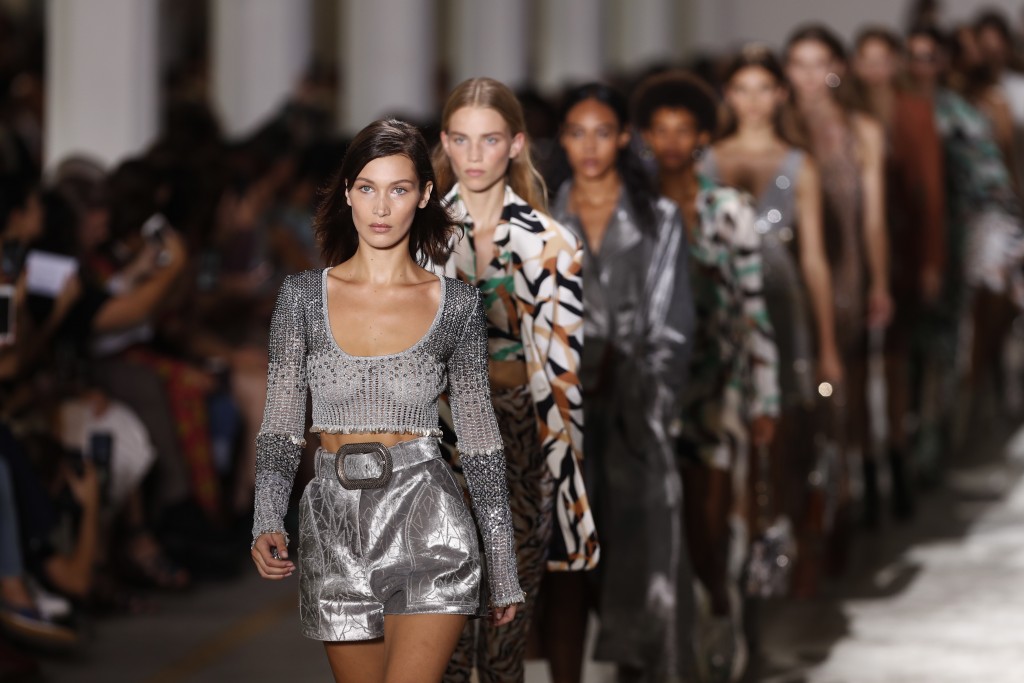
Don’t mistake Milan Fashion Week to be the forgotten showcase, despite the fact that it’s wedged in the centre of London and Paris Fashion Week; it plays host to some of the greatest shows of the season.
Picking up two brands that typically reside in a different fashion home; Milan hosted Peter Pilotto who is usually in London, and Boss who quietly slipped away from New York.
Donatella Versace is a notable mention here as she made undeniable waves on social media by featuring Jennier Lopez on her runway, in a modified version of the very gown that made Google Images a reality.
Similarly, Alessandro Michele boasted a cleaner, more streamlined collection while staying true to his design essence. His collection for Gucci, marking his fifth anniversary with the fashion house, took a step in the more refined direction, ditching the layered looks we’ve previously seen on their runways.
Controversially, many reactions were less than pleased with the new collection, with one model staging a peaceful protest during their walk against the use of straitjacket imagery for the SS20 show.
Whether you’ve come for the huge celebrity names, the animal prints, the vintage florals, the controversies, or the colourful leather; we’ve got your full guide to Milan Fashion Week SS20.
MOSCHINO
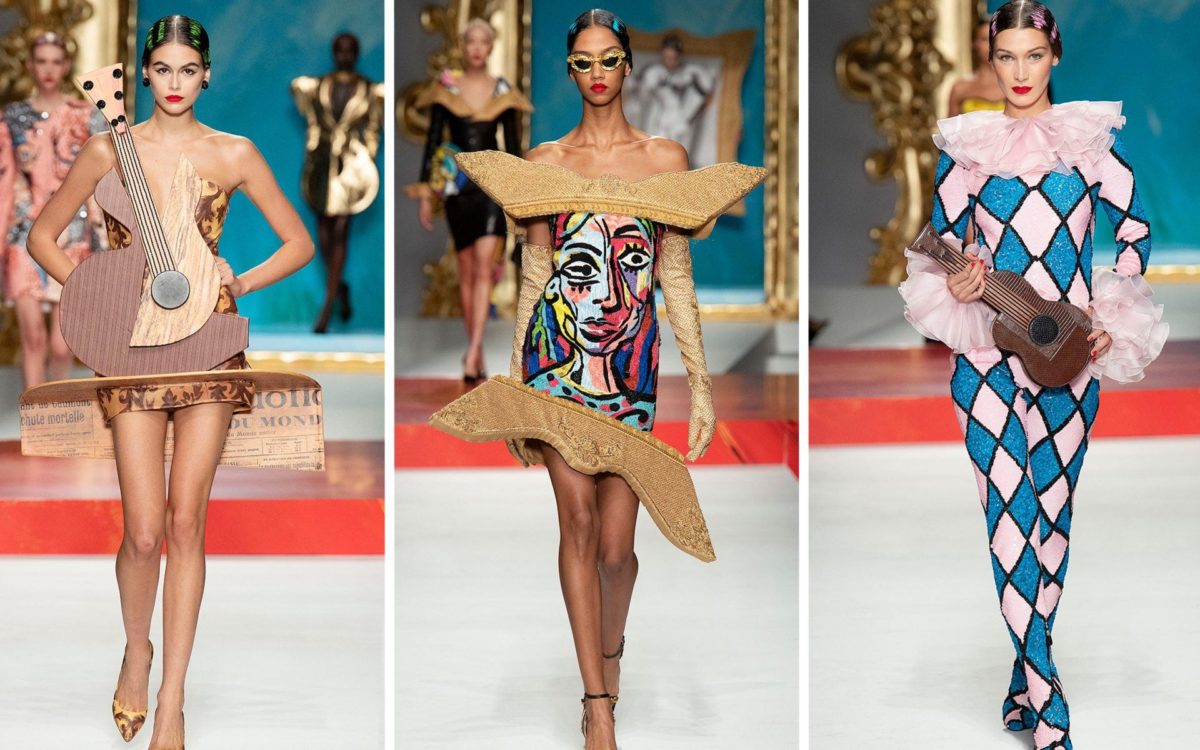
The simple set may have suggested a tame collection, however Jeremy Scott’s show was anything but simple. Bringing art to life, Scott revealed a slew of pieces that were fit for a museum. Many models carried palettes and guitars, with one model becoming the frame for the art-themed show.
Scott’s show notes for the Moschino show stated: “Muses inspire artists and artists inspire the world’.
MARNI

Marni’s show followed in the same artistic direction, although their pieces were centred on sustainability and natural forms of art. With a set made of recompressed-cardboard benches under a repurposed plastic jungle, audiences saw paint printed onto tops, skirts, and dresses.
“Bravo to a major Italian house for putting sustainability front and center! And kudos to Risso for showing a collection that had charm and beauty by the bucketload and upcycled textiles, organic cottons, and ‘recuperated’ leathers. He wanted to create a ‘joyous protest’—‘an homage to nature and our sense of humanity’—and he succeeded,” said Sally Singer for Vogue.
DOLCE & GABBANA
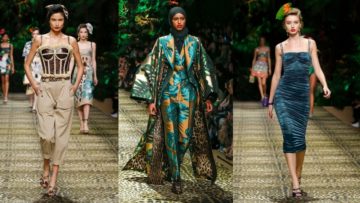
Gabbana’s “Sicilian jungle” theme was unmistakable, with their show space littered with giant palms and leopard print. The 124 look collection featured safari suiting, animal and tropical prints, scarf dressing, resort-wear, and a crocodile skirt-suit that appeared supple to the touch.
“We enjoy making something glamorous, and we love the sense of happiness, summertime. It’s our philosophy,” Gabbana said.
Bottega Veneta
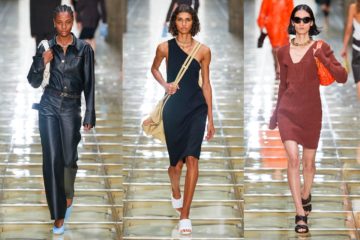
With leather standing as Bottega Veneta’s calling card, the brand showcased paper thin dresses, boilersuits, coats and lightweight waterproof anoraks; all shown on a giant catwalk of Intrecciato (the brand’s signature leather-weaving technique) enclosed under Perspex.
Kitten heels made an appearance, an unsurprising addition given their popularity last season. The show’s highlights were a trio of sequinned cowl-neck dresses in tomato red, pale blue, and gold.
“Spring marks his second runway outing, and what it tells us is that he’s a designer with conviction-there’s no wavering,” said Nicole Phelps for Vogue.
PRADA

Miuccia Prada appeared to take a step in route of environmentally conscious fashion by driving one message home: invest in pieces you will wear forever to retain a non-disposable wardrobe. The items had hints of 70s, even 50s fashion, and all were elegantly reusable.
Pencil and pleated skirts, grey wool trousers that were slightly flared, tailored jackets that shadow your waistline, and a slightly transparent dress in cheesecloth. The collection was filled with different textures and contexts, perfect for the ideal wardrobe.
PETER PILOTTO

The new location seemed to inspire a Milanese collection for Peter Pilotto and Christopher de Vos, who traded their usual elaborate silhouettes for more utility-friendly shapes. The brand presented an artsy vibe filled with rich textural work, whimsical colours and feminine shapes.
Oversized polos, silk shirts in bright colours, workwear, boxy jackets in washed denim, and soft-tailored blazers in shiny satin were all seen on the runway. The collection was a perfect mix of the elaborate essence of the brand, and ready-to-wear designs.
“We’re known for our occasion dressing, perfect for cocktails and parties. This season, we wanted to explore a more every day, utilitarian look. Probably it has to do with us spending so much time here, mixing pleasure and leisure. Exploring the Italian feel for practicality,” said Christopher de Vos.
VERSACE
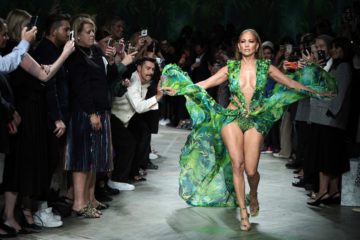
This is the show that temporarily broke the internet, featuring the woman and the dress that’s done that before. J-Lo’s collaboration with Donatella Versace saw the 50-year-old glamazon revisit her gown worn at the 2000 Grammy awards. The same dress that forced Google to create a new search engine (now known as Google Images) to accommodate the staggering number of users searching for images of J-Lo in the green-printed gown.
The finale of the show saw images of the jungle-print dress appearing on the screens that wrapped around the venue space, only to then reveal J-Lo herself walking the runway in a stunning updated version of the dress.
GUCCI

Alessandro Michele, known provocateur, shocked audiences with the beginning of his show for Gucci. The red-lit room flashed white, revealing metal gates that opened and allowed 21 models wearing straightjackets or jackets inspired by them. The models slowly walked through the moving walkway, which abruptly ended as the lights went out.
Michele told the New York Times that he wanted to highlight “how society today can have the ability to confine individuality and that Gucci can be the antidote. For me, the show was the journey from conformity to freedom and creativity.”
Gucci wrote on Instagram that the clothes would not be sold, but that they represented “the most extreme version of a uniform dictated by society and those who control it.”
Despite Gucci’s explanation of the show’s opening, model Ayesha Tan-Jones disagreed with the use of straight-jacket inspired clothing.
The 26-year-old nonbinary model, artist, and musician, chose to peacefully protest the show by writing “mental health is not fashion” on their palms as they walked the runway.
In an Instragram post, Tan-Jones wrote: “As an artist and model who has experienced my own struggles with mental health, as well as family members and loved ones who have been affected by depression, anxiety, bipolar and schizophrenia, it is hurtful and insensitive for a major fashion house such as Gucci to use this imagery as a concept for a fleeting fashion moment.
“It is in bad taste for Gucci to use the imagery of straightjackets and outfits alluding to mental patients while being rolled out on a conveyor belt as if a piece of factory meat.”
The rest of the collection that was featured following this ordeal boasted a side of Michele we have yet to see. Embracing sexiness, the collection shared graphic colour-blocking and lean-lined tailoring, riding crops accessorized lace-inset slip dresses, black vinyl chokers, scoop-necks, and high-slit midi skirts.
While Michele’s bold move towards more daring designs was impressive, it seems as though his daringness in showcasing straightjackets on the runway will be the main thing remembered from Gucci’s Milan 2019 show. Particularly as he seemed to follow straightjackets with sexiness.
To stay up to date with all the Fashion Month collections and shows, subscribe to FIB’s newsletter!






